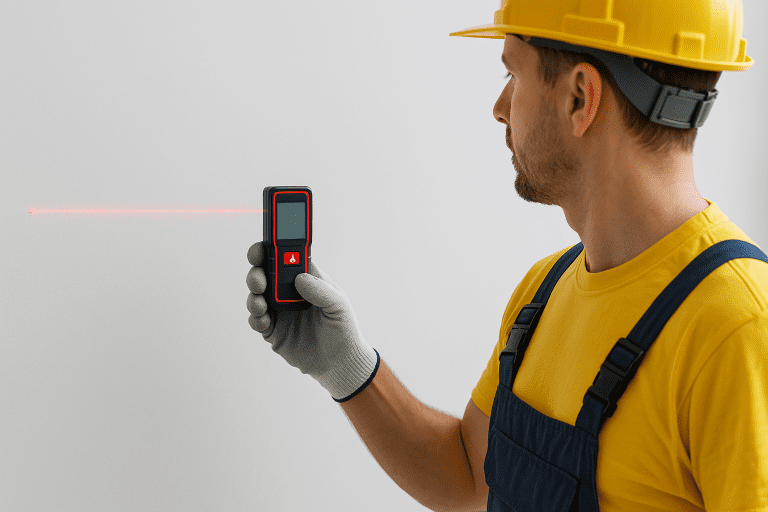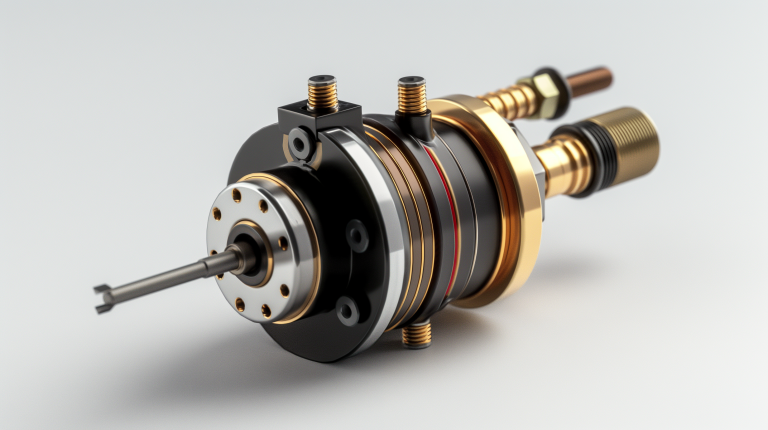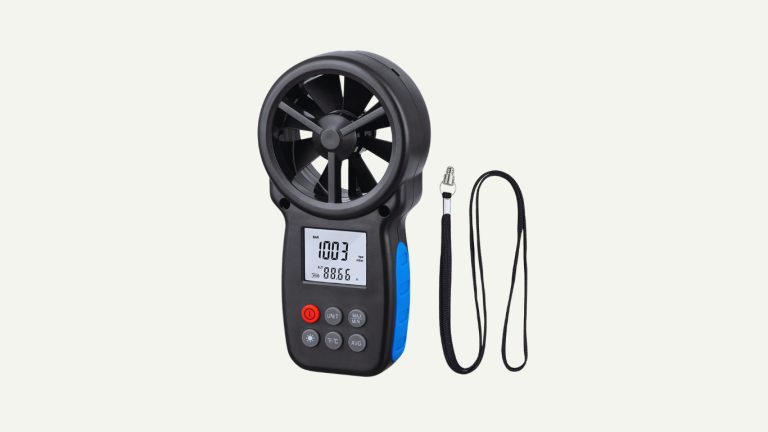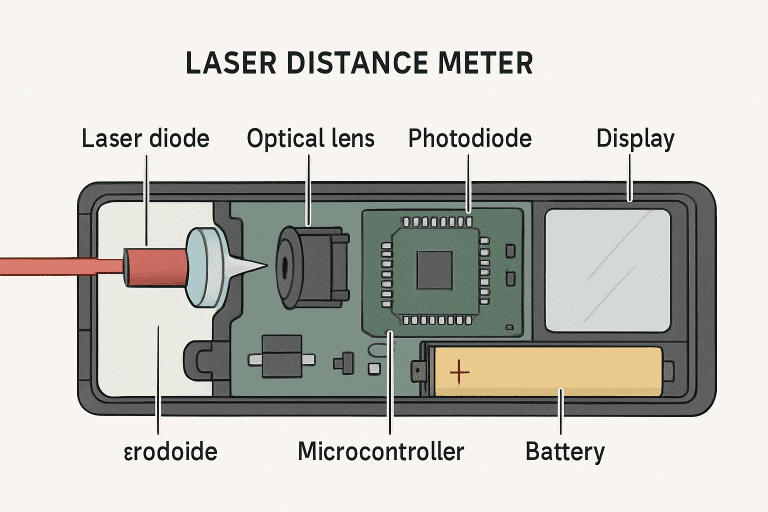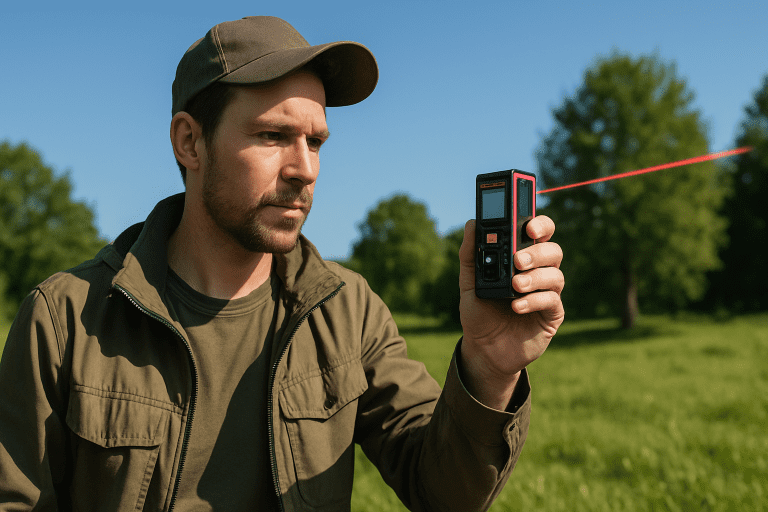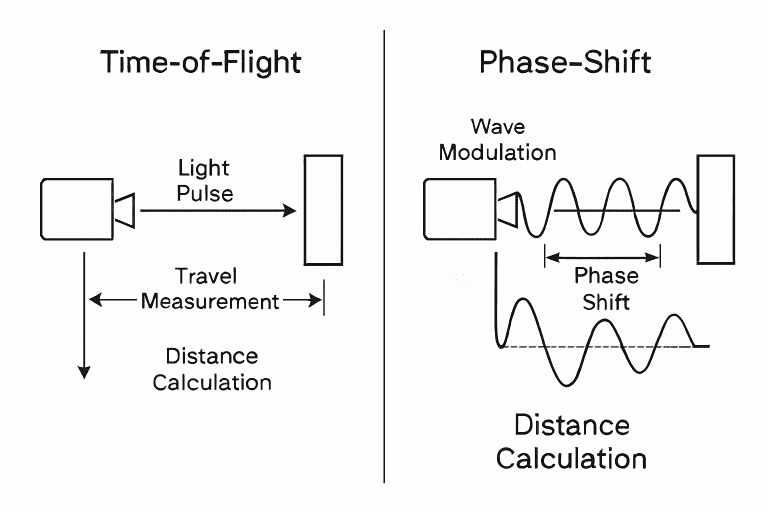
Ever wonder how we spot ground moving before bad things happen? I’ll share something cool. It saves lives and money. As someone who works with ground checks, I see how inclinometers keep us safe.
Think of your phone. It knows when you tilt it. The inclinometer works the same way. But it does bigger jobs. It tracks ground movement. It checks if slopes are stable. Pretty neat, right?
What is an Inclinometer?
Let’s start easy. An inclinometer is like a smart level tool. Some call it a tilt sensor. But it’s much better.
Here’s what it does:
The inclinometer feels Earth’s gravity. Smart! It knows which way is down. When things tilt, it sees it fast.
Build teams love these tools. Mining crews need them too. They use geotechnical monitoring to stay safe.
How Inclinometers Work ?
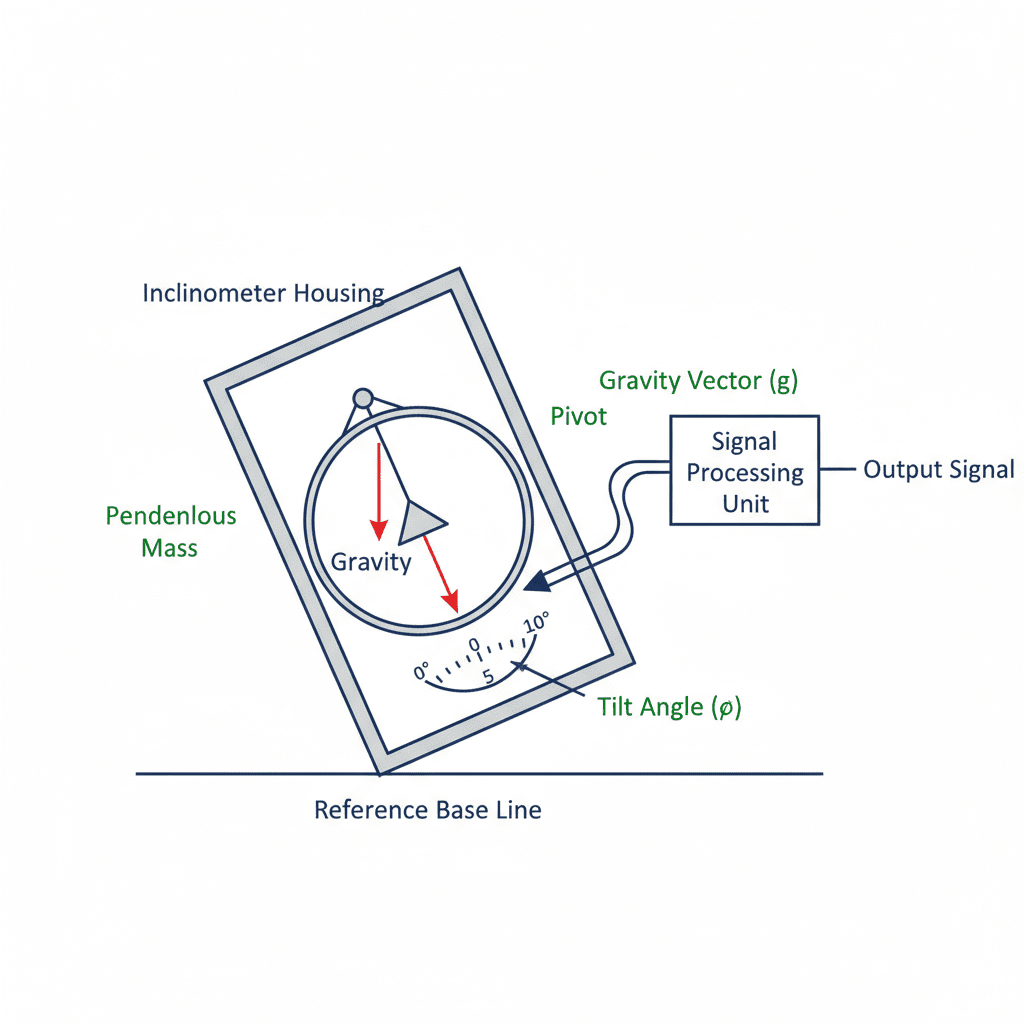
How inclinometer measures tilt angles using gravity as reference point
Using Gravity to Measure
Here’s the cool part. The inclinometer’s working principle uses gravity. It always points down.
Inside the tool, there’s a part that feels gravity’s pull. When ground tilts, this part moves. The tool checks this tiny move. Then it tells us the angle.
Think of a bubble level. But we use high-tech parts instead of bubbles. These parts are super sharp. They catch moves smaller than your nail.
The probe sensor sends facts back to us. We get numbers. These show how much things moved. This helps with displacement measurement and subsurface monitoring.
MEMS Tech in New Inclinometers
Now we talk tech! MEMS means tiny machine systems. Sounds big, but it’s simple.
Inside a MEMS inclinometer, there’s a small moving bit. When the tool tilts, this bit shifts. The shift makes electric signals.
Smart chips handle these signals. The result? Super exact tilt measurement that workers trust.
MEMS technology makes tools smaller and cheaper. But they’re still exact. The sharp levels will amaze you.
Best part? MEMS parts work great for civil engineering instrumentation. They handle tough spots and work for years.
MEMS vs Servo Types
Let me show you the two main types:
|
What
|
MEMS
|
SERVO
|
|---|---|---|
|
Size |
Small |
Big |
|
Cost |
Less |
More |
|
How exact |
Very Good |
Best |
|
Power Use |
Little |
More |
|
Care Needed |
Almost None |
Regular |
Servo systems use force balance tech. They’re super exact but cost more. MEMS systems give great value for most jobs.
For structural health monitoring, both work well. Pick based on your budget and how exact you need it.
Types of Inclinometers
Manual vs Auto Systems
Let me tell you about two ways. Manual inclinometer systems need someone to check them. Auto ones work alone.
Manual systems use a probe sensor on a cable. A worker lowers it into the inclinometer casing. They check at different depths, like checking oil with a stick.
Auto systems have sensors already in place. They send inclinometer readings all the time. No human visits needed. Great for far-off slope monitoring spots.
Here’s what I learned:
Manual systems:
Auto systems:
Still vs Moving Types
Static inclinometers check things that don’t move, like buildings or walls, for embankment monitoring. They watch slow changes.
Dynamic inclinometers handle moving things. Build gear, cranes, or trucks use these. They deal with shaking and fast moves.
For mining safety jobs, moving types work better. They filter out shakes but catch real tilts. Still types work great for tunnel monitoring where changes are slow.
Both help with deformation analysis. The key is picking the right type for your job.
One Way vs Two Way Setup
One way checks tilt in one direction, like north-south moves. Two way covers both directions at once. North-south and east-west.
For borehole measurement, one way often works fine. However, ground movement can go in any direction. That’s where two-way shines.
The cost gap isn’t big now. So most workers pick two way for better cover. It’s like having safety backup.
Main Parts and How They Work
Probe Tech
The probe sensor is the star. Inside, you find motion sensors or MEMS parts. These catch tiny angle changes.
The probe has guide wheels. They ride in grooves. This keeps it lined up right. Water seals keep electronics dry.
Cable links carry power down and data back up. New probes use digital signals for better accuracy. Some even work wirelessly for data logging.
What I love about new probe sensors is that they’re tough and work well. I’ve seen them work in challenging situations for years with no issues.
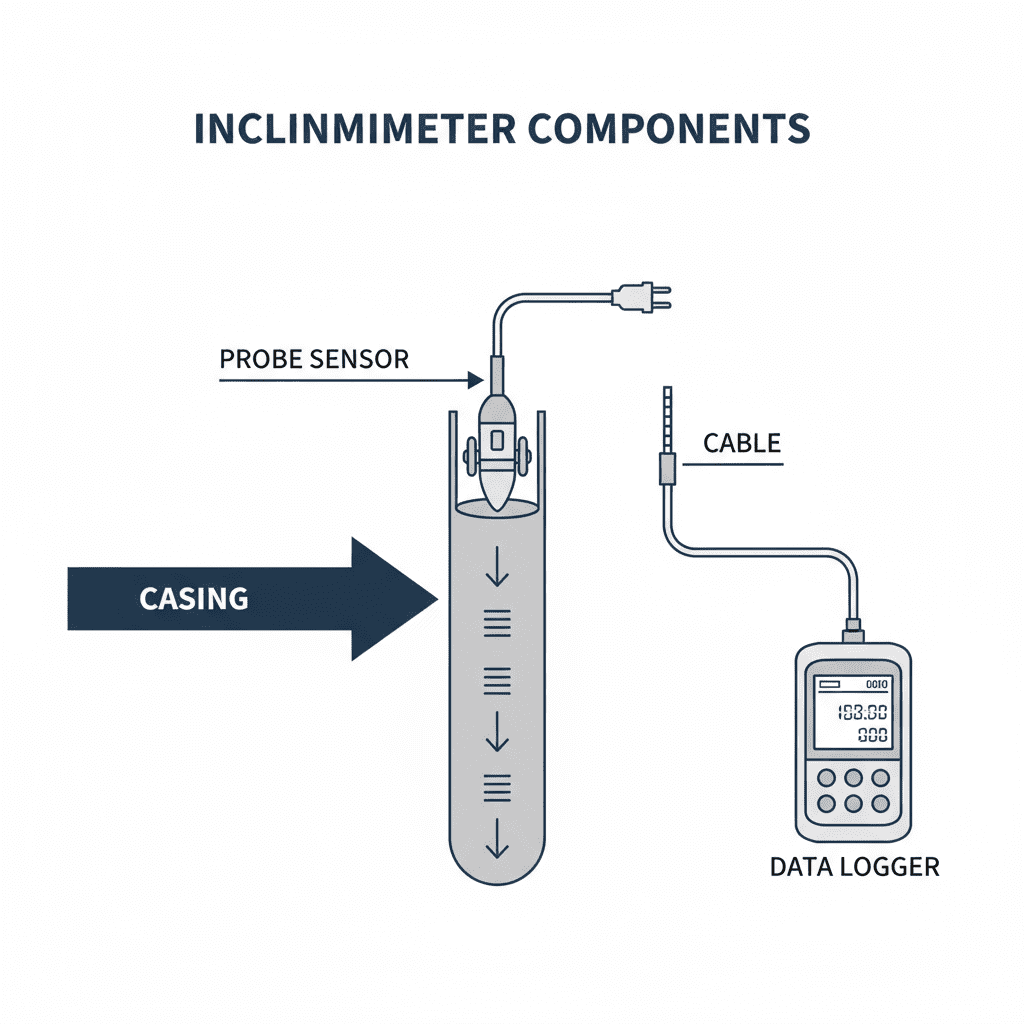
Main parts of an inclinometer system and their functions
Casing and Setup Systems
The inclinometer casing is like a road for the probe. It’s a grooved tube put in a borehole measurement hole.
Setup starts with drilling a hole. Then we lower the casing parts and connect them. Concrete around the casing locks it in place.
The groove system matters a lot. It guides the probe and ensures that readings remain consistent. Good casings last for decades if put in right.
For geotechnical investigation, casing placement is key. We need it to follow ground movement exactly. No cutting corners.
Data Capture and Handling
Data logging systems grab and store readings. Simple ones just save numbers. Smart systems handle data and send alerts.
Digital displays show angles in degrees. Some connect to phones or tablets for easy viewing.
Wireless sending lets us watch far sites from the office. Inclinometer readings show up on our computers right away.
The best systems have trending and analysis tools. They help spot problems before they become disasters.
How to Use Inclinometers: Step by Step
Here’s how we really use these tools:
- Get site ready: Mark the spot and clear paths
- Drill hole: Make a straight hole to the right depth
- Put in casing: Lower casing parts and concrete in place
- Set up system: Connect readout gear and test all
- Take first readings: Get baseline numbers for comparing
- Regular checks: Follow planned reading times
- Look at data: Check trends and watch for worrying changes
- Share findings: Tell the project team what we found
Each step matters. Skip one and you might miss key ground movement. I always double-check connections and setup before leaving a site.
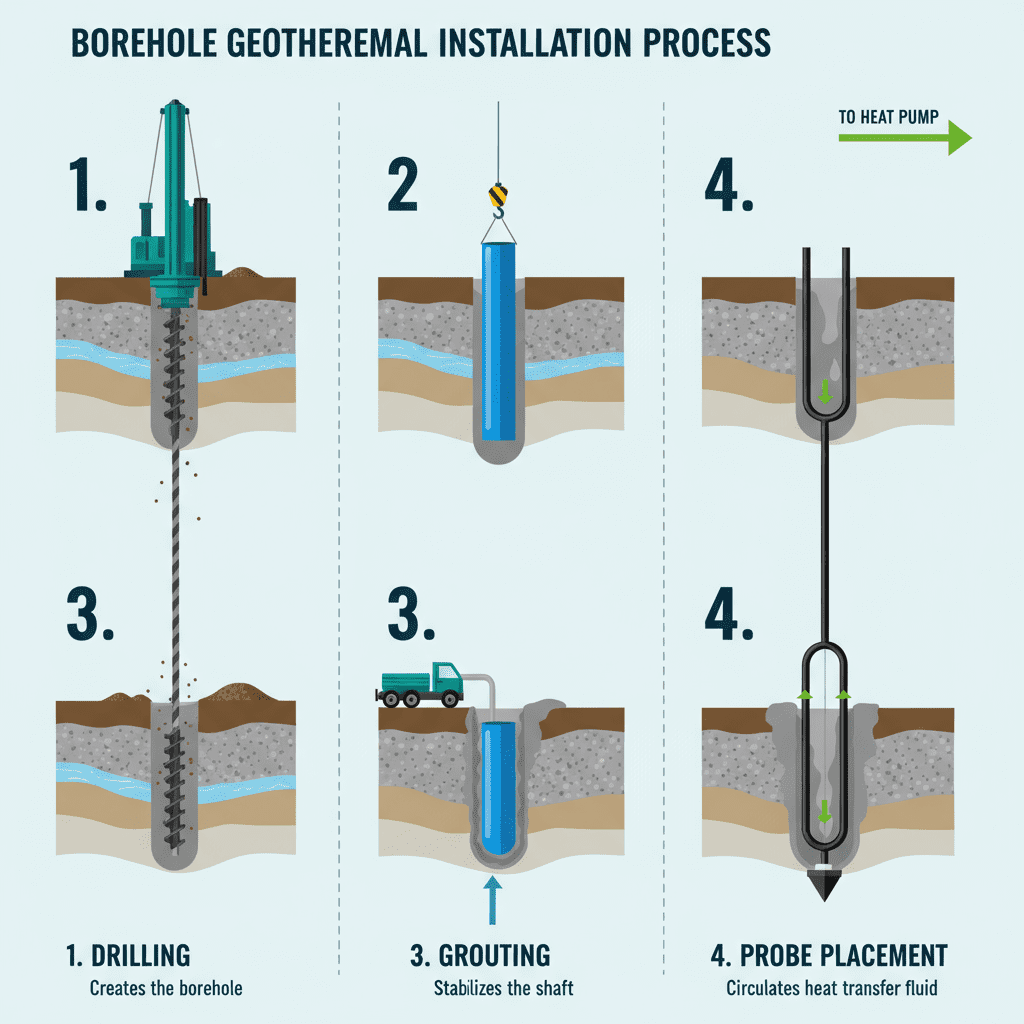
Complete inclinometer installation process in 6 easy steps
The key is doing the same thing every time. Same probe, same depths, same steps. This gives reliable displacement measurement data.
Real Jobs and Examples
Ground Checking Uses
I’ve seen inclinometers save the day many times. Landslide detection systems stop disasters. Slope monitoring keeps roads safe.
Dam projects use them for embankment monitoring. Any settling or moving gets caught early. This stops huge failures that could hurt thousands.
Excavation monitoring keeps nearby buildings safe during build work. We track any ground movement and change work plans as needed.
Retaining wall stability checking gives us peace of mind. These walls hold back tons of dirt. We need to know they stay put.
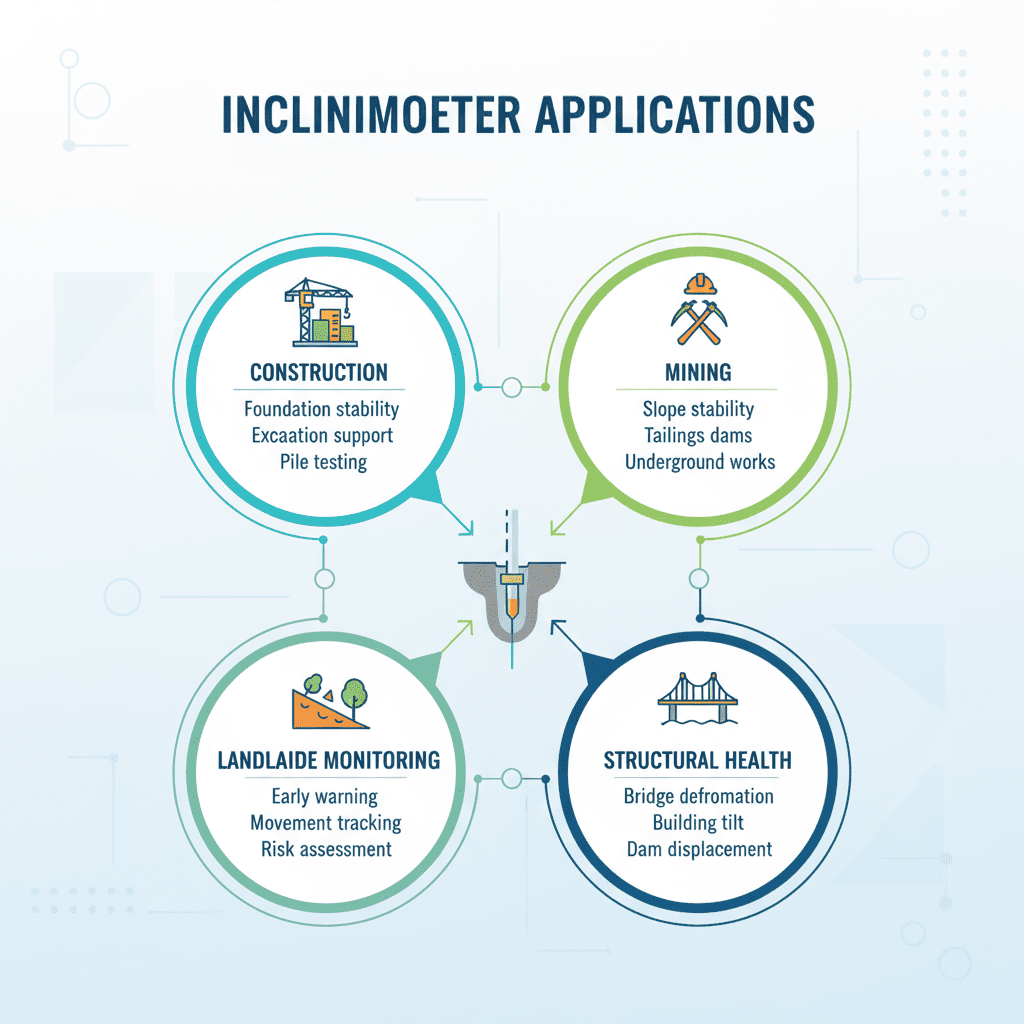
Real-world applications where inclinometers keep us safe
Build and Road Projects
Bridge build projects need lots of subsurface monitoring. We track foundation movement during and after building.
Tunnel monitoring keeps workers safe underground. Ground conditions change. We need to know right away. Inclinometer readings give early warning.
Building foundation work gets help from settlement monitoring. Even tiny moves can crack buildings. Catching them early saves millions in fixes.
Highway projects use civil engineering instrumentation a lot. Slope cuts near roads need constant watching. One failure could close traffic for months.
Mining and Heavy Gear
Mining safety uses are key. Open pit mines have steep slopes. Deformation analysis stops deadly rockslides.
Heavy gear workers count on inclinometers for stability. Cranes and diggers all use tilt measurement systems.
Build vehicles work on bumpy ground. Built-in inclinometers warn workers about dangerous slopes. This stops tip-overs and accidents.
How Exact and Calibration
Understanding Exactness Specs
Inclinometer exactness changes by type and use. MEMS systems usually get ±0.1 to ±0.5 degrees exact. High-end servo types reach ±0.01 degrees.
Heat affects exactness. Good systems have circuits that fix this. They stay exact across wide heat ranges.
Reading exactness depends on the whole system. Probe sensor, casing, and readout all matter. Weak parts reduce total exactness.
For structural health monitoring, we need steady exactness over time. Drift and aging can hurt long-term readings.
Calibration Steps and How Often
Factory calibration sets baseline exactness. But field conditions need regular checks. I suggest every three months for key uses.
Calibration uses known angle references. Special holders put the probe sensor at exact angles. We compare readings to true values.
Data logging systems need calibration too. Digital displays can drift over time. Regular checks make sure exactness continues.
Professional calibration services give certified results. This meets quality standards for important projects.
Error Sources and How to Fix
Heat changes cause the biggest errors. Good systems include auto heat fixing.
Inclinometer casing alignment affects readings. Twisted or bent casing makes systematic errors. Right installation stops most issues.
Cable resistance can cause drift in old systems. Digital systems fight this problem better. Regular cable checks catch growing issues.
Human factors matter in manual systems. Steady procedures reduce worker errors. Training and checklists help keep quality.
Cost Analysis and Picking Equipment
System Pricing Breakdown
Let me give you real numbers. Basic manual inclinometer systems start around $3,000-$5,000. This includes probe sensor, cable, and readout.
Auto systems cost $8,000-$15,000 per setup. Higher price, but no labor costs for readings. They pay for themselves on long jobs.
MEMS systems usually cost less than servo types. But exactness needs might decide the tech choice.
Data logging and wireless features add $2,000-$4,000. Worth it for far sites or key uses.
Selection Guide
Here’s how I pick the right system:
|
What matters
|
Weight |
Manual
|
Auto |
|---|---|---|---|
|
First Cost |
20% |
Great |
Poor |
|
Long Cost |
25% |
Poor |
Great |
|
Accuracy |
25 |
Good |
Greate |
|
Reliability |
25% |
Good |
Very Good |
Geotechnical monitoring needs drive the choice. Short projects favor manual systems. Long-term slope monitoring benefits from auto setup.
Site access matters too. Far locations need auto systems. City sites might allow manual readings.
Money Back Analysis
Prevention always costs less than fixing. One stopped landslide pays for many inclinometer setups.
Insurance companies often require watching for high-risk sites. Inclinometer systems can cut costs a lot.
Early warning stops accidents and saves lives. That’s priceless. But even money-wise, watching pays off.
Project delays from surprise ground movement cost way more than watching systems.
Setup Best Ways and Common Mistakes
Professional Setup Guide
Site prep makes or breaks the setup. Clear access routes for drilling gear. Mark all underground utilities first.
Borehole drilling needs skill and right equipment. Straight holes make sure readings are exact. Crooked holes cause measurement errors.
Inclinometer casing must be handled with care. Damaged grooves affect probe sensor guiding. Check each joint before setup.
Concrete procedures follow strict rules. Complete filling stops casing movement. But avoid too much pressure that might bend the casing.
Common Setup Errors to Avoid
I’ve seen these mistakes too many times:
Each mistake costs time and money to fix. Some need complete redo.
Quality control during setup stops most problems. Check everything twice before covering.
Safety Points
Drilling work needs safety rules. Hard hats, safety glasses, and steel-toed boots are minimum needs.
Electrical safety matters with powered readout equipment. GFCI protection stops shock dangers. Keep connections dry and secure.
Borehole stability can be an issue. Use right casing and concrete to stop collapse. Never enter digs without proper support.
Chemical dangers from concrete materials need ventilation and protective gear. Read all safety data sheets before starting work.
Fixing Problems and Care
Finding and Fixing Problems
When inclinometer readings look wrong, systematic checking helps. Start with the probe sensor – is it working right?
Check cable connections for rust or damage. On-off faults often come from bad connections. Looking catches most issues.
Inclinometer casing problems show up as reading differences. Damaged grooves or blocks affect probe sensor movement.
Data logging system errors might be software or hardware related. Restart procedures solve many electronic problems.
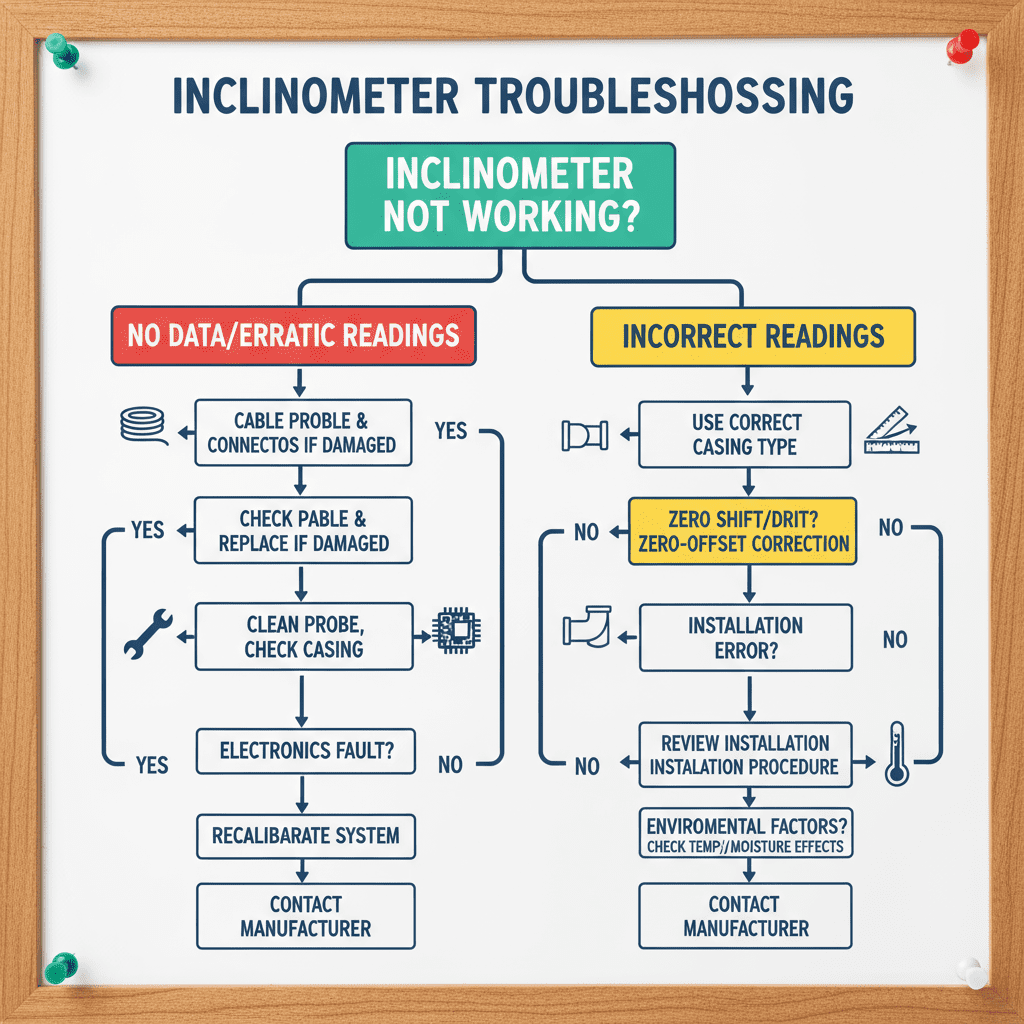
Quick troubleshooting guide for common inclinometer issues
Regular Care Schedule
Monthly visual checks catch growing problems. Look for damaged cables, rusty connections, or equipment wear.
Every three months calibration checks make sure continued exactness. Simple field checks spot drift before it becomes a problem.
Yearly professional care includes complete system testing. This catches problems that routine checks might miss.
Cable replacement every 5-7 years stops failures. Cables work hard and finally wear out. Replace before they fail.
Future Tech and Trends
The inclinometer world keeps growing. MEMS technology gets better and cheaper each year. Exactness improves while costs drop.
Wireless systems get rid of cable problems. Solar power makes far watching practical anywhere. Internet connection enables global tracking.
Smart computers help analyze inclinometer readings. Smart systems spot problems faster than human checkers. They learn from experience and get better over time.
Working with other geotechnical monitoring tools creates complete systems. One platform handles all civil engineering instrumentation data.
Common Questions
Q1. How exact are new inclinometers for ground checking?
New MEMS inclinometers get ±0.1 to ±0.5 degrees exact. High-end servo systems reach ±0.01 degrees. This is plenty exact for most geotechnical monitoring jobs.
Q2. What’s different between MEMS and servo inclinometers?
MEMS systems use tiny machine parts on silicon chips. Servo systems use force-balancing tech. MEMS costs less but servo offers higher accuracy. Both work great for structural health monitoring.
Q3. How often should inclinometers be calibrated?
I suggest every three months for key uses. Yearly checks work for less important uses. Data logging systems might need more frequent attention. Heat fixing reduces calibration frequency.
Q4. Can inclinometers work in bad weather?
Yes! Good systems handle -40°F to +185°F temps. Water seals protect against moisture. Some systems work underwater for subsurface monitoring.
Q5. What causes the most common reading errors?
Heat changes cause the biggest problems. Inclinometer casing damage creates systematic errors. Poor setup and calibration drift also affect exactness.
Q6. How deep can setups be placed?
Standard setups go to 200-300 feet deep. Special systems reach 1000+ feet. Borehole measurement depth depends on ground conditions and project needs.
Q7. How long do systems typically last?
Well-maintained systems last 15-20 years. Probe sensors and electronics might need replacement after 10-12 years. Inclinometer casing can last decades if set up right.
Inclinometers are amazing tools that keep our world safe. They catch problems before disasters happen. From landslide detection to structural health monitoring, these devices save lives and money.
The tech keeps getting better too. MEMS systems offer great value. Wireless data logging makes far watching easy. Smart analysis catches problems faster than ever.
Whether you need slope monitoring, settlement monitoring, or deformation analysis, inclinometers give reliable results. Just remember – right setup and care are key to success.
Stay safe out there, and let the inclinometer be your early warning system!

